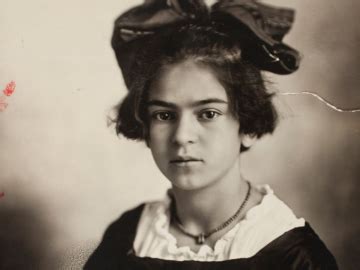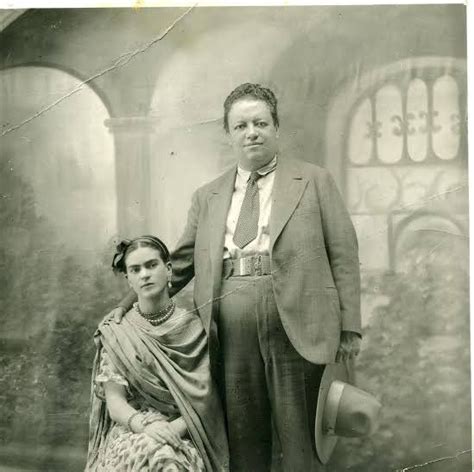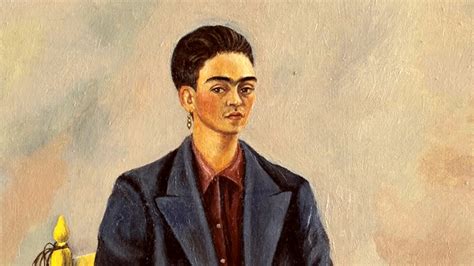Discover the mesmerizing tale of a renowned artist whose legacy continues to inspire and captivate audiences worldwide. This compelling narrative takes us on a remarkable voyage through the life and artistic path of a visionary whose impact on the art world remains unrivaled.
Immerse yourself in the vivid colors and emotive brushstrokes that define this influential figure's body of work. From poignant self-portraits to breathtaking landscapes, each canvas is a window into the artist's inner world, reflecting her triumphs, struggles, and indomitable spirit.
Unleash your imagination as you delve into the complexities of this masterful storyteller's artwork. With each stroke of the brush, she unraveled her deepest emotions, inviting viewers to share in her experiences of heartache, resilience, and the sheer beauty of being human.
Discover how this enigmatic artist challenged societal norms and broke down barriers, paving the way for generations of artists to come. Through her art, she forged a path to empowerment and self-expression, forever changing the perception of what it means to be an artist.
Join us on this immersive journey as we explore the extraordinary life and work of an iconic figure whose legacy continues to shape the art world. Through her remarkable storytelling and visionary approach, she reminds us that art has the power to heal, inspire, and unite us all.
Frida Kahlo's Early Life: Overcoming Polio and embracing the path of an artist

In this section, we delve into the formative years of one of Mexico's most celebrated artists, Frida Kahlo. Explored here is the intriguing tale of her early struggles with polio, and how it influenced her journey towards becoming an exceptional artist.
At a tender age, a crippling illness struck Kahlo, leaving her bedridden for months. Polio, a disease that paralyzed her right leg, presented a significant obstacle in her quest for a normal childhood. However, rather than allowing her condition to define her, Kahlo fiercely defied the limitations imposed upon her, developing a resilience that would later shape her unique artistic perspective.
The adversity faced during Kahlo's early years instilled in her a deep sense of empathy, compassion, and determination. Although she yearned for a life unburdened by physical limitations, she found solace and an outlet for her emotions through art. Kahlo's unwavering spirit propelled her to explore various artistic mediums, honing her skills and refining her distinctive style.
| Key Points | At a Glance |
|---|---|
| Polio | A paralyzing disease that impacted Kahlo's right leg during her early years |
| Resilience | Her determination to overcome physical limitations and pursue her passion for art |
| Empathy | The profound understanding of human suffering that Kahlo developed as a result of her own struggles |
| Artistic Exploration | How Kahlo's pursuit of various artistic mediums shaped her unique style |
Through her art, Frida Kahlo dared to unveil the complexity of the human experience, drawing upon her own challenges and transforming them into works that resonate with audiences to this day. Her early life, marked by the triumph over adversity, ultimately laid the foundation for her remarkable artistic legacy.
The Impact of Mexican Culture on Frida Kahlo's Art
When examining the artistic journey of the renowned Mexican painter, it becomes evident that her work was deeply influenced by the vibrant and rich cultural heritage of Mexico. Kahlo's art reflects a profound connection to the traditions, symbols, and rituals woven into the fabric of Mexican society.
- Mexican Folklore and Mythology: Kahlo drew inspiration from the colorful narratives and mythical figures of Mexican folklore. Her paintings often portrayed characters from ancient legends and incorporated indigenous symbolism to convey powerful messages.
- Traditional Mexican Clothing: The vivid hues and intricate patterns of traditional Mexican attire captivated Kahlo and found their way into many of her self-portraits. By adorning herself in Tehuana dresses and headdresses, she celebrated and embraced her Mexican identity.
- Pre-Columbian Art: Kahlo was deeply fascinated by the ancient art and artifacts of pre-Columbian civilizations, such as the Aztecs and the Mayans. She incorporated elements of their aesthetic, including stylized depictions of gods and goddesses, into her own art to emphasize the continuity of Mexican culture.
- Day of the Dead: Kahlo's art often explored the theme of death, and she drew inspiration from the traditional Mexican holiday, Dia de los Muertos (Day of the Dead). Through her depictions of skeletons and skulls, she celebrated the cycle of life and death and infused her work with a sense of Mexican spirituality.
- Political and Social Commentary: Kahlo's art also reflected the tumultuous political climate of Mexico during her lifetime. She depicted the struggles and hardships faced by her compatriots, addressing issues such as poverty, inequality, and the oppression of indigenous peoples.
Overall, Frida Kahlo's art is a testament to the profound impact of Mexican culture on her creative expression. Through her unique artistic style and powerful symbolism, she brought the essence of Mexico to the global art scene, leaving an indelible mark on the history of art.
A Complicated Love Affair: The Interwoven Lives of Frida Kahlo and Diego Rivera

In this segment, we delve into the intricately entangled bond shared by two iconic figures of the Mexican art scene, Frida Kahlo and Diego Rivera. Their relationship was anything but simple, filled with passion, tumult, and unyielding commitment. This is the story of a love affair that defied conventions and left an indelible mark on the art world.
A Tale of Intense Emotions
The connection between Frida Kahlo and Diego Rivera can only be described as a whirlwind of emotions. Their love was unbridled, encompassing both immense joy and profound sorrow. It was a tangle of fiery arguments, passionate embraces, and a shared understanding of each other's creative souls.
A Journey Through Art and Politics
As artists and activists, Kahlo and Rivera embarked on a journey through the interplay of art and politics. Each regarded their work as a reflection of their staunch beliefs and shared commitment to the marginalized. Their union transcended the boundaries of personal adoration, becoming a platform for social critique and a conduit for change.
Two Souls, Distinct Expressions
Although intertwined, Kahlo and Rivera's artistic expression remained distinctively their own. Kahlo's raw and introspective self-portraits became synonymous with her unyielding spirit and ability to confront her physical and emotional pain. Meanwhile, Rivera's monumental murals showcased his grandiose vision, blending history, politics, and Mexican folklore.
Infidelity and Forgiveness
Their love story, while passionate, was not immune to struggles and infidelity. Both Kahlo and Rivera engaged in extramarital affairs, causing immense pain and heartache. Yet, amidst the turmoil, forgiveness blossomed, and they refused to let their imperfections define their union. Their love endured, drawing strength from vulnerability.
An Enduring Legacy
The love shared between Kahlo and Rivera transcended the boundaries of time. Their names remain entwined and immortalized not only through their art but through the captivating story of their love. The impact they made on each other's lives and the art world as a whole continues to inspire and captivate audiences around the globe.
Frida Kahlo's Feminist Ideals Reflected in her Artwork
Exploring the thematic strands interwoven throughout Frida Kahlo's artistic creations unveils a profound and multifaceted examination of societal constructs, gender roles, and the pursuit of equality. Through her paintings, Kahlo effectively channels her deep-rooted feminist ideals, provoking thought and challenging preconceived notions.
- Embracing Self-Expression and Identity: Kahlo's artwork serves as a powerful vehicle for her exploration of self-identity, embracing her unique perspective as a woman navigating a patriarchal society. With a distinct visual language, she unravels the complexities of gender and identity, asserting the significance of self-expression.
- Questioning Conventional Beauty Standards: Kahlo's paintings present a challenge to societal norms by subverting traditional beauty standards. Through her self-portraits, she celebrates her indigenous heritage and physical imperfections, highlighting the beauty in authenticity and defying societal expectations.
- Voicing Female Experiences: With remarkable candor, Kahlo delves into her personal experiences as a woman, giving voice to the struggles and triumphs of the female experience. Her works touch on themes of fertility, motherhood, and the challenges faced by women in a male-dominated world, resonating with audiences across generations.
- Asserting Autonomy and Independence: Kahlo's artwork often portrays women in positions of power and agency, challenging the concept of male dominance. By depicting herself and other women as strong figures who navigate their own paths, Kahlo inspires and empowers viewers to embrace their autonomy and reshape societal narratives.
- Addressing Social Injustice: Kahlo's art confronts the injustices faced by women and marginalized communities, shedding light on issues such as sexism, racism, and class disparities. Through her vivid symbolism and powerful imagery, she invites viewers to confront and challenge these systemic inequalities.
In conclusion, Frida Kahlo's artistic contributions extend far beyond their aesthetic value. With a keen feminist lens, she delves into the nuances of gender, identity, and societal constructs, inviting viewers to question and reimagine the world around them. Her unique ability to intertwine personal experiences with universal themes solidifies her place as a feminist icon, leaving an indelible mark on the art world and beyond.
Frida Kahlo's Global Recognition and Enduring Legacy

Exploring the Impact and Heritage Left by the Renowned Mexican Painter
Within the realm of international art, few figures have left as indelible a mark as Frida Kahlo. Her artistic prowess and compelling personal narrative have propelled her to an iconic status that transcends borders and cultures. This section delves into Frida Kahlo's widespread recognition and the enduring legacy she has established through her art.
Known for her poignant self-portraits and vivid portrayal of human experiences, Kahlo showcased a unique perspective that resonated with audiences worldwide. Her ability to capture raw emotions and depict universal themes of identity, pain, and resilience has allowed her art to transcend language barriers, connecting with people across generations and continents.
Moreover, Frida Kahlo's impact extends beyond the artistic realm. Her unwavering spirit and refusal to conform to societal norms inspired countless individuals, particularly women, to embrace their own individuality and express their truth. Her unapologetic celebration of Mexican culture and heritage showcased the power of art as a mechanism for social commentary and cultural pride.
Today, Kahlo's influence permeates various aspects of popular culture, from fashion to music, highlighting the lasting reverberations of her art and persona. Her iconic image, with her signature braided hair, vibrant traditional clothing, and unibrow, has become a symbol of strength, resilience, and self-expression.
As Frida Kahlo continues to captivate the imagination and ignite conversations worldwide, her legacy serves as a testament to the enduring power of art to transcend boundaries and advocate for social change. Through her unique artistic vision and unwavering dedication to her craft, Kahlo has secured her place as one of the most remarkable and influential artists of the 20th century, leaving an indelible mark on the artistic landscape that will continue to inspire generations to come.
Exploring the Symbolism and Surrealism in Frida Kahlo's Art
In this section, we will delve into the profound symbolism and surrealism present in the artworks of the renowned Mexican painter. Frida Kahlo's artistic repertoire is characterized by her use of symbols and surrealist elements to convey powerful messages and emotions.
Within Kahlo's artworks, various symbols emerge as visual metaphors, representing her inner thoughts, struggles, and cultural identity. Through these symbols, she expresses her emotions and experiences in a distinct and unconventional manner.
- Kahlo often incorporated the image of the human body, specifically her own, as a symbol of personal identity and physical pain. She used elements such as broken bones, wounds, and thorns to depict the physical and emotional scars she endured throughout her life.
- Another recurring symbol in Kahlo's art is vegetation, particularly thorny plants and tropical flowers. These represent the duality of life, where beauty and pain coexist. The vibrant colors and delicate details of the flora in her paintings further reinforce this contrast.
- Animals, both real and mythical, also feature prominently in Kahlo's works. Birds, monkeys, and deer are often depicted, symbolizing freedom, confinement, and vulnerability respectively. These creatures serve as visual metaphors for the complexities of human existence, reflecting Kahlo's own experiences and emotions.
In addition to symbolism, Kahlo incorporated elements of surrealism in her art, blending reality and fantasy to create thought-provoking compositions. Her paintings often feature dreamlike settings, distorted perspectives, and unusual juxtapositions of objects.
- By embracing surrealism, Kahlo was able to explore her subconscious mind and create artworks that transcended conventional boundaries. Through the use of symbolic and surreal elements, she invites viewers to reflect on their own lives, emotions, and identities.
- Kahlo's unique artistic vision challenged societal norms and paved the way for new interpretations of identity, femininity, and cultural heritage. Her use of symbolism and surrealism continues to captivate audiences worldwide, leaving a lasting legacy in the art world.
In conclusion, Frida Kahlo's symbolism and surrealism in art offer a glimpse into her complex inner world. Through the use of visual metaphors and dreamlike compositions, she invites viewers to explore their own emotions and experiences, transcending traditional artistic boundaries in the process.
FAQ
Who is Frida Kahlo?
Frida Kahlo was a renowned Mexican artist known for her unique style and self-portraits. She was born on July 6, 1907, in Mexico City and is considered one of the most significant figures in 20th-century art.
What made Frida Kahlo's artwork so remarkable?
Frida Kahlo's art was remarkable due to its raw and emotional nature. She depicted her physical and emotional pain through her paintings, often incorporating symbolism and surreal elements. Her works also often explored themes of identity, gender, and Mexican culture, making them highly personal and deeply impactful.
What challenges did Frida Kahlo face during her life?
Frida Kahlo faced numerous challenges throughout her life. She suffered from polio as a child, which left her with a lifelong limp. She also experienced a severe accident at the age of 18, which caused her immense physical pain and led to multiple surgeries and medical treatments. In addition to her physical struggles, Frida Kahlo also faced emotional turmoil, including a tumultuous relationship with her husband, Diego Rivera, and the loss of several pregnancies.
How did Frida Kahlo's personal life influence her artwork?
Frida Kahlo's personal life had a profound impact on her artwork. Her physical and emotional pain, as well as her experiences with love, loss, and identity, were all reflected in her paintings. She often painted herself and incorporated elements of her own life into her art, allowing her to express her innermost thoughts and feelings in a deeply personal and unique way.
Why is Frida Kahlo considered an important figure in art history?
Frida Kahlo is considered an important figure in art history because of her pioneering approach to self-expression and her exploration of themes that were often overlooked or marginalized, such as gender and identity. Her unique style and powerful imagery have had a lasting impact on the art world and continue to inspire artists and art lovers around the world.



